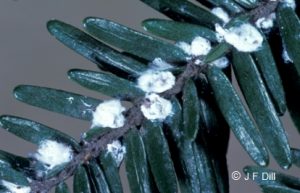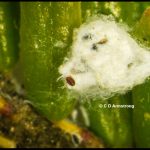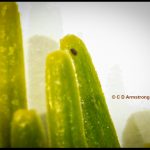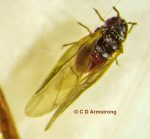Hemlock Woolly Adelgid

The Hemlock Woolly Adelgid (Adelges tsugae), often abbreviated as HWA, is a very small (1/32″ long) invasive Hemipteran (‘true bug’) that feeds on sap that it sucks from hemlock trees (Tsuga spp.). It was accidentally introduced to western North America from its native Asia in 1924, and eventually–decades later–worked its way to the eastern United States, where it has caused widespread mortality of hemlock trees. Over one-third of the native range of hemlock in the eastern US is now infested with HWA. A quarantine has been established for Maine, New Hampshire, and Vermont. Nevertheless, southern areas of all three of these states now have pocket HWA infestations. Note: The revision of the Hemlock Woolly Adelgid Quarantine Rule went into effect as of 9/25/2013.
The desiccation caused by HWA feeding causes the tree to lose its needles and not produce new growth. In the northern portion of the hemlock’s range, the color of the hemlocks infested by HWA will typically change from their healthy, dark green color to a sickly, grayish-green color after just a few years, and death typically occurs four to ten years after an initial infestation. Any trees that do manage to survive the direct effects of a HWA assault are usually weakened to the point where they may die from secondary causes.
HWA reproduces asexually and, in North America, goes through two overlapping generations per year. The distinctive tufts of white, waxy coverings clinging to the undersides of the hemlock branches are what people look for when searching for signs of HWA infestation. These coverings are protective for the adelgids that grow and eventually lay eggs beneath them. Between 100 and 300 eggs are laid by the adults under each one of these sacs! Larvae emerge in the spring and can spread on their own or with the assistance of wind, birds and/or people or other mammals. Avoid placing bird feeders in or near hemlocks to discourage birds from landing there and potentially spreading HWA larvae.
- Portion of an Eastern Hemlock twig infested with Hemlock Woolly Adelgid (North Berwick, ME; 4/15/2022)
- Hemlock Woolly Adelgid (nymph/”crawler” stage; visible in center of photo) (Mount Desert, ME; June 23rd, 2021) The nymphs (“crawlers”) are reddish-brown in color and migrate to new locations on the branches where they subsequently settle into place and feed at the base of the needles.
- Hemlock Woolly Adelgid (nymph/”crawler” stage; one is shown here at the tip of one of the needles) (Mount Desert, ME; June 23rd, 2021)
- Hemlock Woolly Adelgid (winged adult) A winged adult hemlock woolly adelgid is rather rare. They fly off in search of tiger tail spruce (Picea torano) trees to infest, but we do not have that species of spruce in the US and they are incapable of establishing themselves on any of our USA species of spruce trees.
Additional Information and Photos:
- Hemlock Woolly Adelgid (Maine Forest Service) — see also Hemlock Woolly Adelgid in Maine
- Map [pdf] of Hemlock Woolly Adelgid Detections in Maine (Maine Forest Service)
- Hemlock Woolly Adelgid (UMass)
- Hemlock Woolly Adelgid (US Forest Service) (includes a video: Impacts of the Hemlock Wooly Adelgid)
- Hemlock Woolly Adelgid Publications US Forest Service, Northeastern Area)
- New York State: Help Fight the Hemlock Woolly Adelgid (A “Catskill Mountainkeeper” project) (includes a video)
- Hemlock Woolly Adelgid (University of Vermont)
- Helpful Guidelines from Michigan State Univ. Extension: How to treat hemlock trees for hemlock woolly adelgid (for homeowners with hemlock trees infested with hemlock woolly adelgid)
- Biological Control (Beetle Predators of HWA):
- Biological Control of Hemlock Woolly Adelgid [pdf] (Maine Forest Service poster)
- Predator beetles released to control serious pest of hemlock trees (USDA / US Forest Service)
- Biological Controls–HWA Predator Monitoring at Home (NC Dept. of Agriculture & Consumer Services and USDA-FS Forest Health Protection)
- Meet The Beetles! Biological Control of Hemlock Woolly Adelgid (Video by NC Cooperative Extension)




